象征主义的运用,永别了武器
- 格式:doc
- 大小:89.00 KB
- 文档页数:11
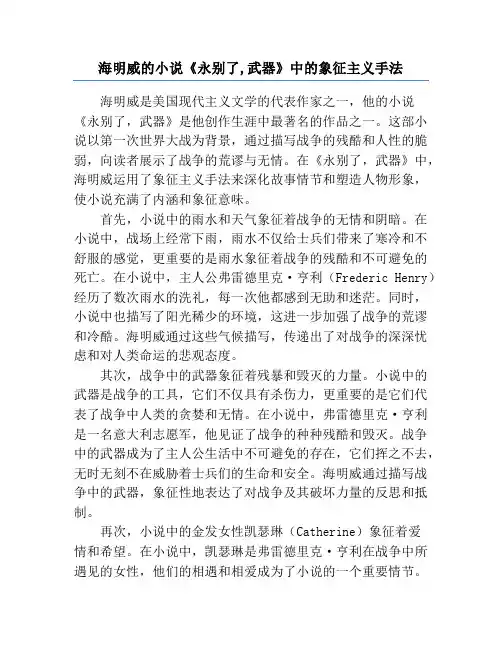
海明威的小说《永别了,武器》中的象征主义手法海明威是美国现代主义文学的代表作家之一,他的小说《永别了,武器》是他创作生涯中最著名的作品之一。
这部小说以第一次世界大战为背景,通过描写战争的残酷和人性的脆弱,向读者展示了战争的荒谬与无情。
在《永别了,武器》中,海明威运用了象征主义手法来深化故事情节和塑造人物形象,使小说充满了内涵和象征意味。
首先,小说中的雨水和天气象征着战争的无情和阴暗。
在小说中,战场上经常下雨,雨水不仅给士兵们带来了寒冷和不舒服的感觉,更重要的是雨水象征着战争的残酷和不可避免的死亡。
在小说中,主人公弗雷德里克·亨利(Frederic Henry)经历了数次雨水的洗礼,每一次他都感到无助和迷茫。
同时,小说中也描写了阳光稀少的环境,这进一步加强了战争的荒谬和冷酷。
海明威通过这些气候描写,传递出了对战争的深深忧虑和对人类命运的悲观态度。
其次,战争中的武器象征着残暴和毁灭的力量。
小说中的武器是战争的工具,它们不仅具有杀伤力,更重要的是它们代表了战争中人类的贪婪和无情。
在小说中,弗雷德里克·亨利是一名意大利志愿军,他见证了战争的种种残酷和毁灭。
战争中的武器成为了主人公生活中不可避免的存在,它们挥之不去,无时无刻不在威胁着士兵们的生命和安全。
海明威通过描写战争中的武器,象征性地表达了对战争及其破坏力量的反思和抵制。
再次,小说中的金发女性凯瑟琳(Catherine)象征着爱情和希望。
在小说中,凯瑟琳是弗雷德里克·亨利在战争中所遇见的女性,他们的相遇和相爱成为了小说的一个重要情节。
凯瑟琳代表了弗雷德里克在战争中寻找到的爱和心灵的归宿。
她的金发象征着光明和希望,在弗雷德里克的人生中,凯瑟琳的出现为他带来了温暖和勇气。
然而,在战争的阴影下,他们的爱情也变得脆弱而不稳定。
最终,凯瑟琳的死亡成为了小说的另一象征,它象征着战争的残酷和无情,以及弗雷德里克失去了爱和希望。
此外,小说中的鸟和动物也被用作象征元素。
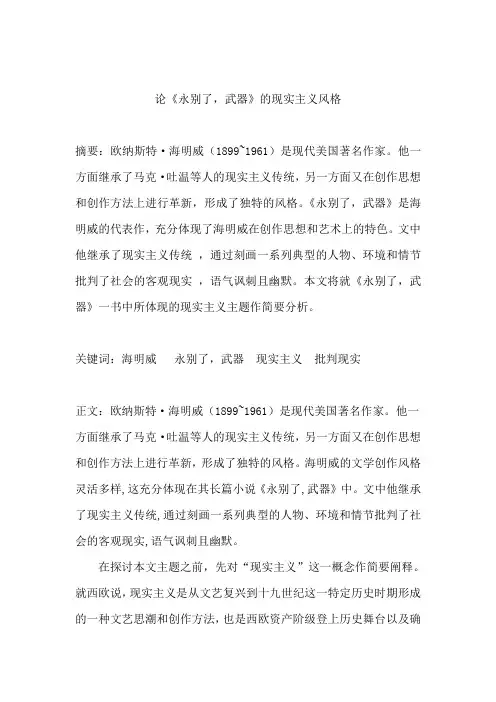
论《永别了,武器》的现实主义风格摘要:欧纳斯特·海明威(1899~1961)是现代美国著名作家。
他一方面继承了马克·吐温等人的现实主义传统,另一方面又在创作思想和创作方法上进行革新,形成了独特的风格。
《永别了,武器》是海明威的代表作,充分体现了海明威在创作思想和艺术上的特色。
文中他继承了现实主义传统,通过刻画一系列典型的人物、环境和情节批判了社会的客观现实,语气讽刺且幽默。
本文将就《永别了,武器》一书中所体现的现实主义主题作简要分析。
关键词:海明威永别了,武器现实主义批判现实正文:欧纳斯特·海明威(1899~1961)是现代美国著名作家。
他一方面继承了马克·吐温等人的现实主义传统,另一方面又在创作思想和创作方法上进行革新,形成了独特的风格。
海明威的文学创作风格灵活多样,这充分体现在其长篇小说《永别了,武器》中。
文中他继承了现实主义传统,通过刻画一系列典型的人物、环境和情节批判了社会的客观现实,语气讽刺且幽默。
在探讨本文主题之前,先对“现实主义”这一概念作简要阐释。
就西欧说,现实主义是从文艺复兴到十九世纪这一特定历史时期形成的一种文艺思潮和创作方法,也是西欧资产阶级登上历史舞台以及确立政治统治时期出现的一种文学现象。
作为文学的一个专门术语,现实主义最早出现在十八世纪德国的剧作家席勒的理论著作中。
但是,"现实主义"作为一种文艺思潮、文学流泥和创作方法的名称广则首先出现于法国文坛.法语中的Realisme一词,来源于拉丁文Realistas(现实,实际)。
现实主义名称的出现和这种文艺思潮的存在完全是两码事。
在法国,现实主义之称始于十九世纪五十年代。
最初,由法国小说家商弗洛利(1821--1599)用现实主义当作表现艺术新样式的名词,他于1850年在《艺术中的现实主义》一文中,初次用这个术语作为批判现实主义文学艺术的标志。
其后,法国画家库尔贝(1819--1877)在绘画上提倡现实主义。
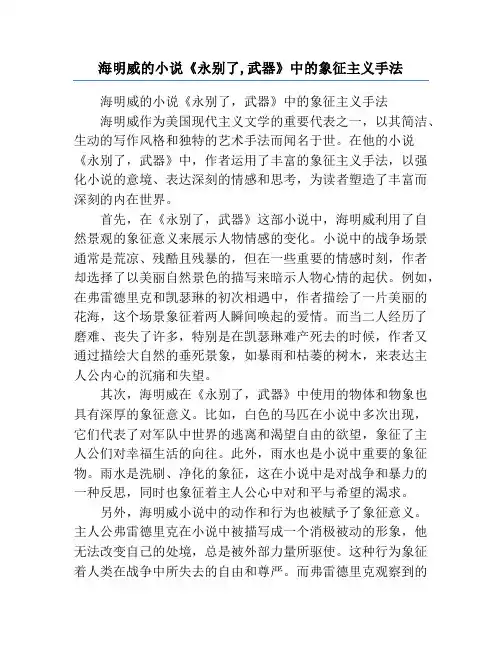
海明威的小说《永别了,武器》中的象征主义手法海明威的小说《永别了,武器》中的象征主义手法海明威作为美国现代主义文学的重要代表之一,以其简洁、生动的写作风格和独特的艺术手法而闻名于世。
在他的小说《永别了,武器》中,作者运用了丰富的象征主义手法,以强化小说的意境、表达深刻的情感和思考,为读者塑造了丰富而深刻的内在世界。
首先,在《永别了,武器》这部小说中,海明威利用了自然景观的象征意义来展示人物情感的变化。
小说中的战争场景通常是荒凉、残酷且残暴的,但在一些重要的情感时刻,作者却选择了以美丽自然景色的描写来暗示人物心情的起伏。
例如,在弗雷德里克和凯瑟琳的初次相遇中,作者描绘了一片美丽的花海,这个场景象征着两人瞬间唤起的爱情。
而当二人经历了磨难、丧失了许多,特别是在凯瑟琳难产死去的时候,作者又通过描绘大自然的垂死景象,如暴雨和枯萎的树木,来表达主人公内心的沉痛和失望。
其次,海明威在《永别了,武器》中使用的物体和物象也具有深厚的象征意义。
比如,白色的马匹在小说中多次出现,它们代表了对军队中世界的逃离和渴望自由的欲望,象征了主人公们对幸福生活的向往。
此外,雨水也是小说中重要的象征物。
雨水是洗刷、净化的象征,这在小说中是对战争和暴力的一种反思,同时也象征着主人公心中对和平与希望的渴求。
另外,海明威小说中的动作和行为也被赋予了象征意义。
主人公弗雷德里克在小说中被描写成一个消极被动的形象,他无法改变自己的处境,总是被外部力量所驱使。
这种行为象征着人类在战争中所失去的自由和尊严。
而弗雷德里克观察到的许多景象和人物的举止,也通过小说情节和描写成为了对战争的讽刺与批判。
此外,还有一些细微的象征元素也在小说中被巧妙运用。
比如,情节之间的时间跳跃和弗雷德里克的内心独白,都为读者呈现了一种模糊、迷离的感觉,这象征了主人公内在的思想与情感的纷乱与矛盾。
同时,作者还将旅途和旅行作为一个主要的象征元素,弗雷德里克在历经了一系列的旅程,通过旅行来进行内心的探索和自我认知。
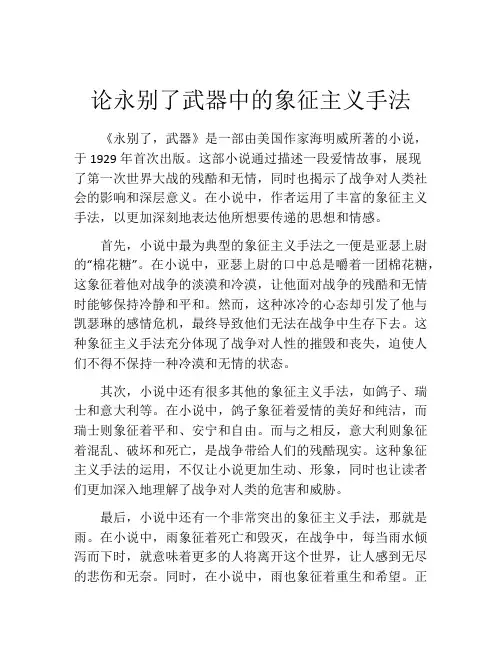
论永别了武器中的象征主义手法《永别了,武器》是一部由美国作家海明威所著的小说,于1929年首次出版。
这部小说通过描述一段爱情故事,展现了第一次世界大战的残酷和无情,同时也揭示了战争对人类社会的影响和深层意义。
在小说中,作者运用了丰富的象征主义手法,以更加深刻地表达他所想要传递的思想和情感。
首先,小说中最为典型的象征主义手法之一便是亚瑟上尉的“棉花糖”。
在小说中,亚瑟上尉的口中总是嚼着一团棉花糖,这象征着他对战争的淡漠和冷漠,让他面对战争的残酷和无情时能够保持冷静和平和。
然而,这种冰冷的心态却引发了他与凯瑟琳的感情危机,最终导致他们无法在战争中生存下去。
这种象征主义手法充分体现了战争对人性的摧毁和丧失,迫使人们不得不保持一种冷漠和无情的状态。
其次,小说中还有很多其他的象征主义手法,如鸽子、瑞士和意大利等。
在小说中,鸽子象征着爱情的美好和纯洁,而瑞士则象征着平和、安宁和自由。
而与之相反,意大利则象征着混乱、破坏和死亡,是战争带给人们的残酷现实。
这种象征主义手法的运用,不仅让小说更加生动、形象,同时也让读者们更加深入地理解了战争对人类的危害和威胁。
最后,小说中还有一个非常突出的象征主义手法,那就是雨。
在小说中,雨象征着死亡和毁灭,在战争中,每当雨水倾泻而下时,就意味着更多的人将离开这个世界,让人感到无尽的悲伤和无奈。
同时,在小说中,雨也象征着重生和希望。
正是因为雨水为植物的成长提供了充足的水分和营养,因此雨也给人们带来了重生和生机。
这种象征主义手法,使得小说不仅突出了战争对人类的危害,同时也给予了人们对未来的希望和信仰。
总体来看,《永别了,武器》中的象征主义手法非常丰富多彩,从而让小说更加深刻地表达了作者的思想和情感。
同时,这些象征主义手法让读者能够更加生动、形象地感受到战争对人类的破坏和危害。
虽然这部小说已经出版了近一个世纪,但其中传递的思想和情感依然能够深深地触动着人们的内心。
相信通过我们的共同努力,我们能够摆脱战争的阴影,创造出一个更加和平、美好的未来。
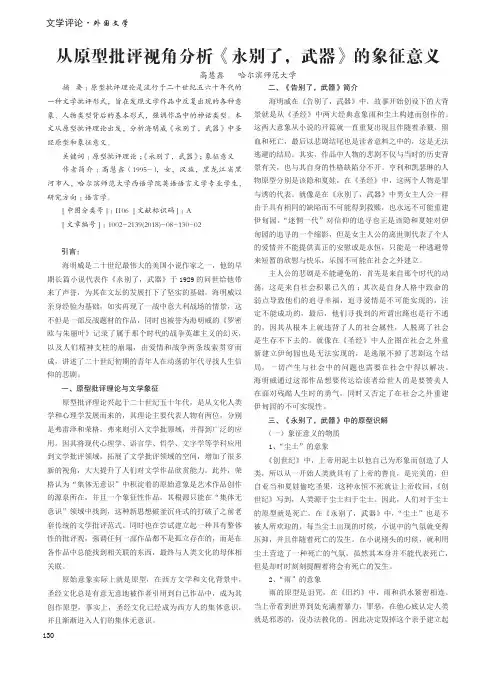
文学评论·外国文学从原型批评视角分析《永别了,武器》的象征意义高慧鑫 哈尔滨师范大学摘 要:原型批评理论是流行于二十世纪五六十年代的一种文学批评形式,旨在发现文学作品中反复出现的各种意象、人物类型背后的基本形式,强调作品中的神话类型。
本文从原型批评理论出发,分析海明威《永别了,武器》中圣经原型和象征意义。
关键词:原型批评理论;《永别了,武器》;象征意义作者简介:高慧鑫(1995-),女,汉族,黑龙江省黑河市人,哈尔滨师范大学西语学院英语语言文学专业学生,研究方向:语言学。
[中图分类号]:I106 [文献标识码]:A[文章编号]:1002-2139(2018)-08-130-02引言:海明威是二十世纪最伟大的美国小说作家之一,他的早期长篇小说代表作《永别了,武器》于1929的问世给他带来了声誉,为其在文坛的发展打下了坚实的基础。
海明威以亲身经验为基础,如实再现了一战中意大利战场的情景,这不但是一部反战题材的作品,同时也被誉为海明威的《罗密欧与朱丽叶》记录了属于那个时代的战争英雄主义的幻灭,以及人们精神支柱的崩塌,由爱情和战争两条线索贯穿而成,讲述了二十世纪初期的青年人在动荡的年代寻找人生信仰的悲剧。
一、原型批评理论与文学象征原型批评理论兴起于二十世纪五十年代,是从文化人类学和心理学发展而来的,其理论主要代表人物有两位,分别是弗雷泽和荣格,弗来则引入文学批领域,并得到广泛的应用。
因其将现代心理学、语言学、哲学、文字学等学科应用到文学批评领域,拓展了文学批评领域的空间,增加了很多新的视角,大大提升了人们对文学作品欣赏能力。
此外,荣格认为“集体无意识”中积淀着的原始意象是艺术作品创作的源泉所在,并且一个象征性作品,其根源只能在“集体无意识”领域中找到,这种新思想破釜沉舟式的打破了之前老套传统的文学批评范式。
同时也在尝试建立起一种具有整体性的批评观,强调任何一部作品都不是孤立存在的,而是在各作品中总能找到相关联的东西,最终与人类文化的母体相关联。
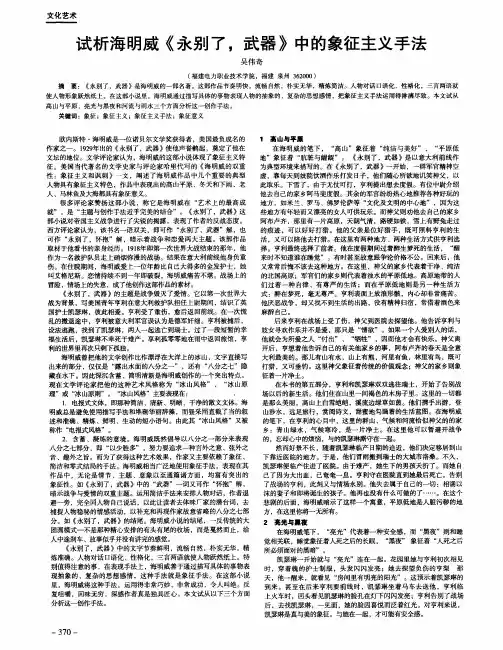
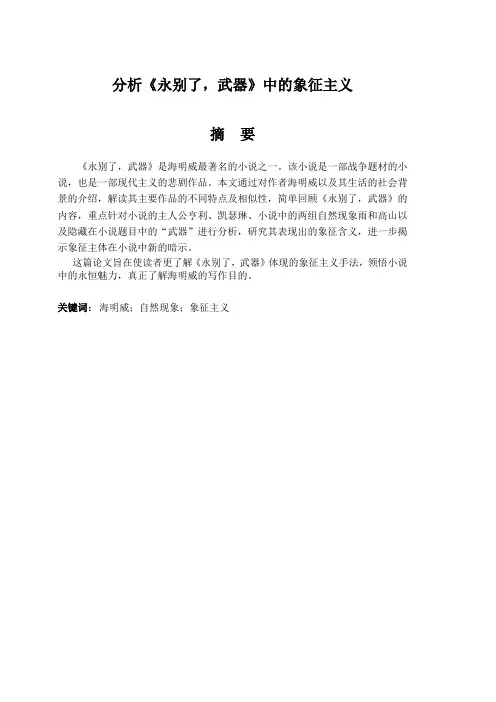
分析《永别了,武器》中的象征主义摘要《永别了,武器》是海明威最著名的小说之一。
该小说是一部战争题材的小说,也是一部现代主义的悲剧作品。
本文通过对作者海明威以及其生活的社会背景的介绍,解读其主要作品的不同特点及相似性,简单回顾《永别了,武器》的内容,重点针对小说的主人公亨利、凯瑟琳、小说中的两组自然现象雨和高山以及隐藏在小说题目中的“武器”进行分析,研究其表现出的象征含义,进一步揭示象征主体在小说中新的暗示。
这篇论文旨在使读者更了解《永别了,武器》体现的象征主义手法,领悟小说中的永恒魅力,真正了解海明威的写作目的。
关键词:海明威;自然现象;象征主义The Analysis of the Symbolism in A Farewell To ArmsABSTRACTA farewell to Arms is one of the most outstanding works written by Hemingway. The novel is a great masterpiece in doom as well as a tragedy in modern sense. This thesis is written to study different symbolic meaning and reveal the new insinuation of symbolic objects by firstly introducing Hemingway and his living backgrounds, then analysing different characters and similarities of his works, reviewing the contents of A Farewell to Arms, and especially focusing on analysing Henry, Catherine, the rain, the mountain, and the arms.The thesis is written to enable readers to get a better understanding of symbolism presented in this novel and to comprehend the eternal charm of this novel, knowing the genuine purpose of Hemingway's writing.Keywords:Hemingway; arms; symbolismCONTENTS摘要 .....................................................................................错误!未定义书签。
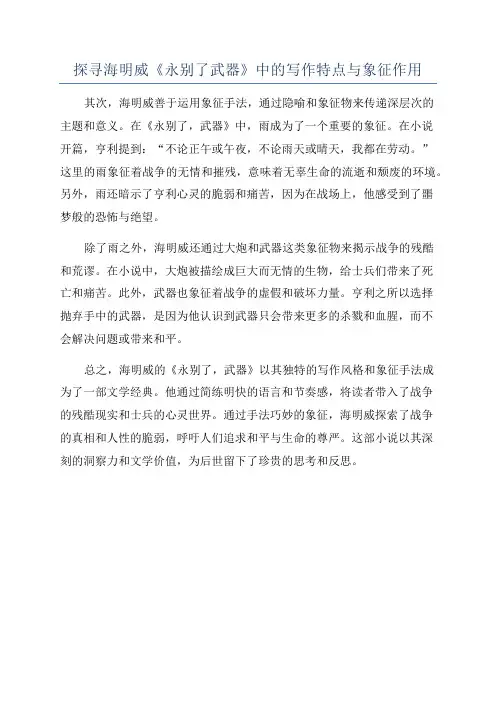
探寻海明威《永别了武器》中的写作特点与象征作用
其次,海明威善于运用象征手法,通过隐喻和象征物来传递深层次的
主题和意义。
在《永别了,武器》中,雨成为了一个重要的象征。
在小说
开篇,亨利提到:“不论正午或午夜,不论雨天或晴天,我都在劳动。
”
这里的雨象征着战争的无情和摧残,意味着无辜生命的流逝和颓废的环境。
另外,雨还暗示了亨利心灵的脆弱和痛苦,因为在战场上,他感受到了噩
梦般的恐怖与绝望。
除了雨之外,海明威还通过大炮和武器这类象征物来揭示战争的残酷
和荒谬。
在小说中,大炮被描绘成巨大而无情的生物,给士兵们带来了死
亡和痛苦。
此外,武器也象征着战争的虚假和破坏力量。
亨利之所以选择
抛弃手中的武器,是因为他认识到武器只会带来更多的杀戮和血腥,而不
会解决问题或带来和平。
总之,海明威的《永别了,武器》以其独特的写作风格和象征手法成
为了一部文学经典。
他通过简练明快的语言和节奏感,将读者带入了战争
的残酷现实和士兵的心灵世界。
通过手法巧妙的象征,海明威探索了战争
的真相和人性的脆弱,呼吁人们追求和平与生命的尊严。
这部小说以其深
刻的洞察力和文学价值,为后世留下了珍贵的思考和反思。
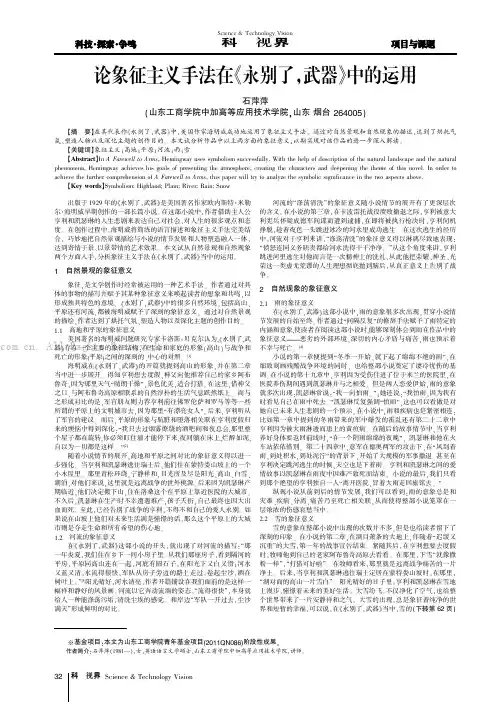
出版于1929年的《永别了,武器》是美国著名作家欧内斯特·米勒尔·海明威早期创作的一部长篇小说。
在这部小说中,作者借助主人公亨利和凯瑟琳的人生悲剧来表达自己对社会、对人生的很多观点和态度。
在创作过程中,海明威将简练的语言描述和象征主义手法完美结合,巧妙地把自然景观描绘与小说的情节发展和人物塑造融入一体,达到寄情于景、以景带情的艺术效果。
本文试从自然景观和自然现象两个方面入手,分析象征主义手法在《永别了,武器》当中的运用。
1自然景观的象征意义象征,是文学创作时经常被运用的一种艺术手法。
作者通过对具体的事物的描写并赋予其某种象征意义来唤起读者的想象和共鸣,以形成独具特色的意境。
《永别了,武器》中的很多自然环境,包括高山、平原还有河流,都被海明威赋予了深刻的象征意义。
通过对自然景观的描绘,作者达到了烘托气氛、塑造人物以及深化主题的创作目的。
1.1高地和平原的象征意义美国著名的海明威问题研究专家卡洛斯·贝克尔认为,《永别了,武器》存在一个主要的象征结构:在生命和家庭的形象(高山)与战争和死亡的形象(平原)之间的深刻的、中心的对照。
[1]海明威在《永别了,武器》的开篇就提到高山的形象,并在第二章当中进一步展开。
得知亨利想去度假,神父向他推荐自己的家乡阿布鲁奇,因为那里天气“晴朗干燥”,景色优美,适合打猎。
在这里,借神父之口,与阿布鲁奇高原相联系的自然淳朴的生活气息跃然纸上。
而与之形成对比的是,军官朋友则力荐亨利前往佛罗伦萨和罗马等等一些所谓的平原上的文明城市去,因为那里“有漂亮女人”。
后来,亨利听从了军官的建议。
而后,平原的形象与肮脏和堕落相关联在亨利度假归来的懊恼中得到深化:“我只去过烟雾燎绕的酒吧间和夜总会,那里整个屋子都在旋转,你必须盯住墙才能停下来,夜间躺在床上,烂醉如泥,自以为一切都是这样。
”[2]随着小说情节的展开,高地和平原之间对比的象征意义得以进一步强化。
当亨利和凯瑟琳逃往瑞士后,他们住在蒙特娄山坡上的一个小木屋里。
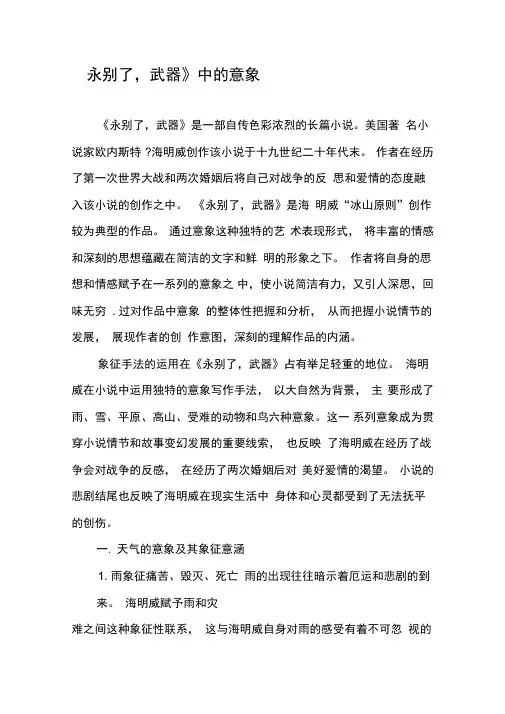
永别了,武器》中的意象《永别了,武器》是一部自传色彩浓烈的长篇小说。
美国著名小说家欧内斯特?海明威创作该小说于十九世纪二十年代末。
作者在经历了第一次世界大战和两次婚姻后将自己对战争的反思和爱情的态度融入该小说的创作之中。
《永别了,武器》是海明威“冰山原则”创作较为典型的作品。
通过意象这种独特的艺术表现形式,将丰富的情感和深刻的思想蕴藏在简洁的文字和鲜明的形象之下。
作者将自身的思想和情感赋予在一系列的意象之中,使小说简洁有力,又引人深思,回味无穷. 过对作品中意象的整体性把握和分析,从而把握小说情节的发展,展现作者的创作意图,深刻的理解作品的内涵。
象征手法的运用在《永别了,武器》占有举足轻重的地位。
海明威在小说中运用独特的意象写作手法,以大自然为背景,主要形成了雨、雪、平原、高山、受难的动物和鸟六种意象。
这一系列意象成为贯穿小说情节和故事变幻发展的重要线索,也反映了海明威在经历了战争会对战争的反感,在经历了两次婚姻后对美好爱情的渴望。
小说的悲剧结尾也反映了海明威在现实生活中身体和心灵都受到了无法抚平的创伤。
一.天气的意象及其象征意涵1. 雨象征痛苦、毁灭、死亡雨的出现往往暗示着厄运和悲剧的到来。
海明威赋予雨和灾难之间这种象征性联系,这与海明威自身对雨的感受有着不可忽视的联系。
在海明威一生的信件中都充斥着对潮湿的、阴雨连绵的天气的抱怨。
阴冷潮湿的雨天会触及他心中的忧郁。
海明威在战争期间目睹过太多行军部队和难民在雨中见你前线的场面了。
雨的意象贯穿于整部小说,从战争前线阴雨连绵到最后女主角凯瑟琳在雨夜难产而死,都伴随着雨。
雨的反复出现也为小说奠定了沉重、伤感的基调,预示着主人公的悲剧命运。
“……The rain beg ins to fall in the October …the leaves all fell from the trees and the branches were bare and the trunks black with rain … all the country wet and brown and dead with the autumn ..... ”在小说的开头部分描写了冬季来临,雨水没完没了的下着,霍乱也随之充斥着人们的生活。
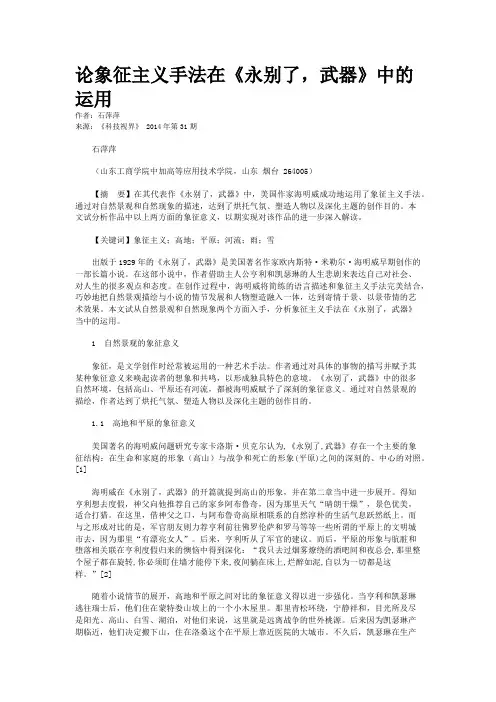
论象征主义手法在《永别了,武器》中的运用作者:石萍萍来源:《科技视界》 2014年第31期石萍萍(山东工商学院中加高等应用技术学院,山东烟台 264005)【摘要】在其代表作《永别了,武器》中,美国作家海明威成功地运用了象征主义手法。
通过对自然景观和自然现象的描述,达到了烘托气氛、塑造人物以及深化主题的创作目的。
本文试分析作品中以上两方面的象征意义,以期实现对该作品的进一步深入解读。
【关键词】象征主义;高地;平原;河流;雨;雪出版于1929年的《永别了,武器》是美国著名作家欧内斯特·米勒尔·海明威早期创作的一部长篇小说。
在这部小说中,作者借助主人公亨利和凯瑟琳的人生悲剧来表达自己对社会、对人生的很多观点和态度。
在创作过程中,海明威将简练的语言描述和象征主义手法完美结合,巧妙地把自然景观描绘与小说的情节发展和人物塑造融入一体,达到寄情于景、以景带情的艺术效果。
本文试从自然景观和自然现象两个方面入手,分析象征主义手法在《永别了,武器》当中的运用。
1 自然景观的象征意义象征,是文学创作时经常被运用的一种艺术手法。
作者通过对具体的事物的描写并赋予其某种象征意义来唤起读者的想象和共鸣,以形成独具特色的意境。
《永别了,武器》中的很多自然环境,包括高山、平原还有河流,都被海明威赋予了深刻的象征意义。
通过对自然景观的描绘,作者达到了烘托气氛、塑造人物以及深化主题的创作目的。
1.1 高地和平原的象征意义美国著名的海明威问题研究专家卡洛斯·贝克尔认为,《永别了,武器》存在一个主要的象征结构:在生命和家庭的形象(高山)与战争和死亡的形象(平原)之间的深刻的、中心的对照。
[1]海明威在《永别了,武器》的开篇就提到高山的形象,并在第二章当中进一步展开。
得知亨利想去度假,神父向他推荐自己的家乡阿布鲁奇,因为那里天气“晴朗干燥”,景色优美,适合打猎。
在这里,借神父之口,与阿布鲁奇高原相联系的自然淳朴的生活气息跃然纸上。
简述《永别了,武器》的艺术特色。
《永别了,武器》是海明威的一部具有代表性的小说,揭示了第
一次世界大战的惨痛和荒谬。
这部小说的艺术特色可以表现为以下几点:
一、现实主义描绘
海明威以现实主义的手法来描绘小说中的场景和人物,尤其是在
描绘第一次世界大战的战争场面方面表现出色。
他通过真实而细致的
描写,将战争的残酷和荒谬呈现在读者面前。
二、意象象征的运用
小说中运用了众多的象征和意象,如透过女主角凯瑟琳的爱情,
表达了一种对美好幸福的渴望和追求;同时,雨水、水银温度计等意
象也被用来象征相关联的意义,增强小说的艺术和意境效果。
三、刻画人物的简洁准确
海明威在人物形象描写方面以简洁、准确的笔法展现了每个人物
头脑与身心的特点,全方位地揭示出了战争给人性带来的损害和影响。
同时他更注重性格的叙述,让读者有机会真正理解每个人物内心的独
特和感情。
四、语言的简洁明了
海明威小说的语言非常简洁,更注重读者的联想和自我想象而不
是刻意的讲述,尤其在场景描写和人物对白上更是如此。
小说的语言
质朴,仿佛回答了20世纪学者的呼吁“表达尽最忌妨碍阅读者思考”。
综上所述,海明威在《永别了,武器》中的艺术手法多种多样且
协调,全面描绘了战争给人类带来痛苦的一面,也从美学的角度出发
倡导人类尊重生命、追求和平和平共处。
《永别了,武器》中的意象作者:韦梦杰来源:《青年文学家》2014年第12期摘要:意象的运用是海明威成就其冰山风格的奥妙之一。
《永别了,武器》是海明威“冰山原则”创作较为典型的作品。
通过意象这种独特的艺术表现形式,将丰富的情感和深刻的思想蕴藏在简洁的文字和鲜明的形象之下。
本文将以《永别了,武器》为蓝本,对该小说中的雨、雪、平原、高山、受难的动物和鸟六种意象进行系统研究,逐个分析其象征和比喻意义,以期揭示海明威隐藏在小说下那八分之七的冰山内涵,从而揭示小说深刻的主题思想。
关键词:意象;海明威;永别了武器作者简介:韦梦杰(1992-),女,汉族,安徽含山人,本科在读,江汉大学外语学院英语系,主要从事美国文学与文化研究。
[中图分类号]:I106 [文献标识码]:A[文章编号]:1002-2139(2014)-12-0-02《永别了,武器》是一部自传色彩浓烈的长篇小说。
美国著名小说家欧内斯特·海明威创作该小说于十九世纪二十年代末。
作者在经历了第一次世界大战和两次婚姻后将自己对战争的反思和爱情的态度融入该小说的创作之中。
《永别了,武器》是海明威“冰山原则”创作较为典型的作品。
通过意象这种独特的艺术表现形式,将丰富的情感和深刻的思想蕴藏在简洁的文字和鲜明的形象之下。
作者将自身的思想和情感赋予在一系列的意象之中,使小说简洁有力,又引人深思,回味无穷.过对作品中意象的整体性把握和分析,从而把握小说情节的发展,展现作者的创作意图,深刻的理解作品的内涵。
象征手法的运用在《永别了,武器》占有举足轻重的地位。
海明威在小说中运用独特的意象写作手法,以大自然为背景,主要形成了雨、雪、平原、高山、受难的动物和鸟六种意象。
这一系列意象成为贯穿小说情节和故事变幻发展的重要线索,也反映了海明威在经历了战争会对战争的反感,在经历了两次婚姻后对美好爱情的渴望。
小说的悲剧结尾也反映了海明威在现实生活中身体和心灵都受到了无法抚平的创伤。
摘要:象征主义是海明威作品的重要艺术风格,《永别了武器》中大量运用了这一写作手法,其中对自然景物及人物的描写都具有深刻的象征意义,在作者的笔下,书中的风雨、高山不再是单纯的自然现象,它们同时暗示着主人公遭遇,预示着主人公的命运。
关键词:象征;雨;高山;人物的象征一、自然环境的象征在《永别了武器》中有许多的对自然环境的描写,这些环境的描写不止是小说事件的叙述和故事情节的发展的需要,同时也具有其特定的象征意义,用来表现小说的主题。
例如:雨象征苦难、厄运,低地象征战争和死亡,高山象征幸福、和平和安宁等。
其中,大量使用的是的是雨的象征意义。
1.雨的象征意义在《永别了武器》中,海明威赋予“雨”特殊的象征意义,“雨”这个字眼伴随着整个故事情节的发展,作为整部书的主题贯彻始终。
在小说中,“雨”是一切不幸和苦难的象征,同时也预示着主人公的悲剧性的命运,每一次“雨”的出现,都对预示着苦难和不幸,也预示着主人公悲剧的开始。
作品一开始就展示出一幅萧瑟凄惨的景象:漫天的尘土和枯黄的落叶,秋末的寒风和初冬的阴雨。
一切似乎在序幕中就预示着一个灾难的结局。
在小说的开篇写道“冬季一开始,就下起了绵绵不绝的雨,阴雨又带来了霍乱。
但是霍乱被制止了,军队里只有七千人死于霍乱。
”。
这是小说中第一次将“雨”和“死亡”联系在一起,连绵不断的阴雨一直伴随着灾难和不幸,在阴雨中霍乱继起,军队里一下子就死了七千多人。
战争未起先折兵马,不祥之兆给全篇奠定了低沉的格调。
此时的阴雨在整个作品中起着陪衬作用,在以后的章节中,作者无数次地提到了雨,雨几乎成了不可缺少的背景。
部队在雨中行进,亨利和其他三个战友在雨中艰难的撤退,亨利浅析《永别了武器》中的象征辛磊(许昌学院外国语学院)利相信,如果军人像冻结的琥珀中的虫子一样,那么现在、将来永远都存在,死亡就只是外表上的事情了。
所以听到什么人死了,就可以耸耸肩说:“就那么回事”。
小说体现出作者强烈的反战情绪,还以人道主义思想表达了对人类不幸事件的同情、讽刺了宗教的虚伪性。
谈海明威《永别了,武器》中意象手法的运用A Talk about the Use of Imagery in Hemingway’s A Farewellto Arms摘要在众多伟大的美国作家中,海明威以其独特的写作风格而著称。
在他所有的作品中,《永别了,武器》这部小说是最能体现他独特写作手法的一部作品。
这部小说语言看似简洁自然,其实却蕴含了作者的精心揣摩和润色加工。
小说简洁自然的语言背后隐藏了深刻的意义和感情。
海明威在小说中运用了独特的意象写作手法——即形象化比喻的方法。
小说中有多个意象并且被巧妙地贯穿起来。
海明威以大自然为背景,形象生动地描写了高山的广阔,平原的危险,雨的不期而至等。
本文主要讨论这篇小说的意象手法的运用。
全文共分为七个象征,分别是高山、平原、水、星星、雨、雪和凯瑟琳的头发,并逐个分析了它们的比喻和象征意义。
很显然海明威善于意象手法的使用。
本文通过分析了七个事物的象征意义,来探讨意象手法在小说中的使用特点。
能使读者从不同的观察角度得到不同的象征意义,更好的来解读《永别了,武器》这部世界性经典作品。
使读者能从不同的角度得到不同的主题。
对内涵和新意具有更进一层的理解。
关键词:意象手法高山平原水雨Being distinguished from many great American writers, Hemingway is noted for his writing techniques. Among all of his works,A Farewell to Arms is a typical one which can display his unique writing techniques among his novels. The language Hemingway uses in this novel is simple and natural superficially but actually they're selected deliberately and artificial. The simplicity of the novel is highly suggestive and often reflects the strong undercurrent of emotion. In A Farewell to Arms,Hemingway uses his unique imagery technique that is a metaphor to describe the characters or settings in a novel. He employs the nature as the background of his novel. This essay not only analyzes the clarity of the mountains, the danger of the plains and the unknown of the rain and so on, but also mainly discusses the use of image in the novel. There are seven symbols analyzed in this essay: mountains, plains, water, stars on Frederic’s uniform, rain, snow and Catherine’s hair. And it analyzes the metaphorical and symbol meanings of mountains, plains, water, stars on Frederic’s uniform, rain, snow and Catherine’s hair. It’s clear that Hemingway is good at employing the imagery technique. By analyzing the metaphorical and symbolic meaning of mountains, plains, water, stars on Frederic’s uniform, rain, snow and Catherine’s hair,presented in i t. The paper aims to explore the features of Hemingway’s use of imagery in the novel and make readers have a good comprehension of the different symbolic meanings from different perspectives and understand the theme fully from different aspects in order to read this novel, the world classic work.Key words: imagery technique mountains plains water rain1Introduction (1)2 A General Introduction to Ernest Hemingway and his Novel, A Farewell toArms (2)2.1A Brief Introduction to Hemingway (2)2.2A Brief Introduction to A Farewell to Arms (3)3 Comment on Writing Technique of Hemingway’s A Farewell to Arms─theUse of Image (5)3.1 The Imagery Use of Mountains and Plains (5)The Mountains (6)The Plains (8)3.2 The Imagery Use of Water and the Stars on Frederic’s Uniform (9)Water (9)The Stars on Frederic’s Uniform (11)3.3 The Imagery Use of Rain and Snow (11)Rain (11)Snow (14)3.4 The Imagery Use of Catherine’s Hair (15)4 Conclusion (15)References (17)1. IntroductionErnest Hemingway has always been one of the world's best-known novelists for the use of imagery techniques. His writing styles and techniques of image are more different from others especially. He uses them very well that the readers do not always pick them up. The novel A Farewell to Arms written by Hemingway is a classic about the love story of a nurse and a war-ridden soldier. The story starts as Henry, the main character in A Farewell to Arms, serving in the Italian Army. He meets his future love in the hospital that he gets put in for various reasons; A Farewell to Arms is a good novel with a lot of symbols. Imagery is placed strategically through the novel.In A Farewell to Arms, Hemingway uses his unique imagery technique that is a metaphor to describe the characters or settings in a novel. He uses the nature to structure the novel. Nature serves as a basic structure for the plot and the actions that occur and the background of his novel. It also emerges as a source of symbols that replace human sentiment or feelings. When Catherine, the heroine dies, there is no mention of sadness or pain. Instead, Hemingway only uses rain as the symbol of her death. The replacement of emotions with symbols allows Hemingway to frequently understate what is really going on in the action. He further uses symbols to completely omit references to sentiments or feelings. This essay not only analyzes the clarity of the mountains, the danger of the plains and the unknown of the rain and so on, but also mainly discusses the use of image in the novel. It can be divided into seven symbols analyzed in this essay: mountains, plains, water, stars on Frederic’s uniform, rain, snow and Catherine’s hair. And it analyzes the metaphorical and symbolic meanings of mountains, plains, water, stars on Frederic’s uniform,rain, snow and Catherine’s hair. It’s clear that Hemingway is good at employing the imagery technique. By analyzing the metaphorical and symbolic meaning of mountains, plains, water, stars on Frederic’s uniform, rain, snow and Catherine’s hair, the paper aims to explore the features of Hemingway’s use of imagery in the novel and make readers have a good comprehension of different symbolic meanings from the different perspectives and understand the theme fully from different aspects in order to read this novel──the world classic work. A Farewell to Arms is full of facts, most of which comes from Hemingway's own experience. So the way to use a variety of symbols is also a very important writing technique employed in this novel. This essay mainly discusses the symbols of the novel. And it's clear thatHemingway is good at presenting images.2. A General Introduction to Ernest Hemingwayand his Novel, A Farewell to Arms2.1 A Brief Introduction to HemingwayErnest Hemingway was born in Oak Park, near Chicago on July 21, 1899. His father, a well-to-do physician bequeathed his son a way of life, and of death, initiated him into the rituals of hunting and fishing in the Upper Peninsula of Michigan. In 1917, after graduation from high school, Ernest Hemingway went to work as a reporter for The Kansas City Star. Rejected for army service in the World War I because of poor vision, he volunteered to serve as a driver for an American ambulance unit in France. Hemingway then transferred to duty on the Italian front, where he was seriously wounded in the explosion of a mortar shell. He was the first American to be wounded in Italy during World War I. After his recovery, and with decorations for which he believed he did not deserve, Hemingway returned home. He worked for the Toronto Star, covered the Grace-Turkish war as a foreign correspondent, and then returned to Paris, Hemingway-along with Gertrude Stein, Ezra Pound, T.S.Eliot, and James Joyce-accomplished a revolution in literary style and language.They were called the Last Generation in American Literature. Hemingway developed a spare, tight, reportorial prose based on simple sentence structure, the use of a restricted vocabulary, precise imagery, and an impersonal, dramatic tone. His three stories and ten poems were published in 1923.With the publication of The Sum Also Rises, three years later, Hemingway became the spokesman for what Gertrude Stein had called “The Lost G eneration”.His works have sometimes been read as an essential commentary on a modern world filled with sterility, failure, and death. Yet such a nihilistic vision is repeatedly modified by Hemingway affirmative assertion of the possibility of living with style and courage. His primary concern was an individual’s “moment o f truth,” and his fascination with the threat of physical emotional or psychic death is reflected in his novels (A Farewell to Arms, published in 1929, and For Whom the Bell Tolls, published in which mainly described the cruel war and the scenes of the wars, 1904), The bullfight (Death in the Afternoon, 1932), [9] and the hunt (The Green Hills of Africa, 1935). To Hemingway, man’s greatest achievement is to show grace under pressure, or what he described in The SunAlso Rises as holding the “purity of line through the maximum of exposure”.Hemingway’s stat us as a writer was confirmed with the publication of in his novel, A Farewell to Arms, 1929.The novel chiefly portrayed the main characters’desire for saying a farewell to war and longing for gaining love. Hemingway had rejected the romantic ideal of the ultimate unity of loves, suggesting instead that all relationship of the main characters would end in their death. In1937, he became a foreign correspondent covering the Spanish Civil War. Three years later he published For Whom the Bell Tolls. Witnessing and experiencing the Spanish Civil War. Hemingway restated his view of love which was lost due to the war and described the indomitable spirit of the common people .In 1952 the same judgment was reflected in his portrayal of the old fisherman, Santiago, triumphant even in defeat, in the old Man and the Sea.For his novels and for his shout stories, which include some of the finest in the English language? Hemingway received wide acclaim. In 1954 he was award ed a Nobel Prize for his “mastery of the art of modern narration.” He became a public figure whose pronouncements and adventures were publicized and scrutinized throughout the world. Numerous Parallels exist between the events of Hemingway’s life and those of his characters, but few were closer than those of Richard Cantwell, the hero of Across the River and into the Trees (1950), whose eventual suicide foreshadowed the struggles and defeats of Hemingway’s final years. In the early morning of July 2, 1961, standing beside his beloved gun rack in his home, he died of head wounds resulting from the discharge of his favorite shotgun, in his own hand.2.2 A Brief Introduction to A Farewell to ArmsA Farewell to Arms is one of Ernest Hemingway’s famous novels which announce Hemingway’s opposition to wars. The author wrote the novel by adopting the first call to narrate the story.Lieutenant Frederic Henry, a main character was a young American attached to an Italian ambulance unit on the Italian front. When Henry returned to the front leave he learned from his friend, Lieutenant Rinaldi, which a group of British nurses had arrived during his absence to set up a British hospital unit. Rinaldi introduced him to a nurse named Catherine Barkley.Between ambulance trips to evacuation posts at the front, Henry called on Barkley, The young man and girl fell in love with each other but he couldn’t stay with her because he should go to the front. Before he left for the front to take, shegave him a St. Anthony medal as a gift.At the front, as Henry and some Italian ambulance drivers were eating in a dugout, an Austrian projectile exploded over them Henry, badly wounded in the legs, was taken to a field hospital. Later he was moved to a hospital in Milan. Catherine Barkley came to the hospital and Henry recognized that she was in his lover and he became very excited. The doctors told Henry that he would have to lie in bed for six months before they could operate on his knee. Meanwhile, Catherine Barley managed to stay with Henry constantly. After his operation Henry convalesced in Milan with Catherine Barkley as his attendant.Summer passed into autumn. Henry’s wound healed and he was due to take convalescent leave in October. He and Catherine planned to spend the leave together, but he came down with jaundice before he could leave the hospital. The day before he left for the front, Henry and Catherine stayed together in a hotel room; already she had disclosed to him that she was pregnant.Henry returned to the front with orders to load his three ambulances with hospital equipment and go south into the Povalley. Morale was at low ebb. Rinaldi admired the job, which had been done on the knee and observed that Henry acted like a married man. War weariness was all- pervasive. At the front, the Italians, having learned that Germ divisions have reinforced the Austrians, began their terrible retreat from Caporetto. During the night the retreat was halted in the rain for hours.At daybreak Henry cut out of the long line and drove across country in an attempt to reach Udine by side roads. The ambulance got stuck in a muddy side road.By that time the Italian army was nothing but a frantic mob Soldiers were throwing down their arms and officers were cutting insignia of rank from their sleeves. Henry was detained, but in the dark of night he fled free, plunged into the river, and escaped on a log. He crossed the Venetian plain on foot. Then jumped aboard a freight train and rode to Milan, where he went to the hospital in which he had been a patient. There he learned that the English nurses had gone to Stresa.During the retreat from Caporetto Henry had made his farewell to arms. He borrowed civilian clothes from an American friend in Milan and went by train to Stresa, where he met Catherine, who was on leave. The bartender of the hotel in which Henry was staying offered his boat by means of which Henry and Catherine could escape to Switzerland. Henry rowed all night. They reachedSwitzerland safely and were arrested. Henry told the police that he was a sportsman who enjoyed rowing and that he had come to Switzerland for the winter sports. The valid passports and the ample funds that Henry and Catherine possessed saved them from serious trouble with the authorities.During the rest of the fall and the winter the couple stayed at an inn outside Montreux.When the time for Catherine’s confinement approached, she and Henry went to Lausanne to be near a hospital, because Catherine was to give birth to a baby. At the hospital Catherine’s pains caused the doctor to use an anesthetic on her. Suffering from pair for hours she gave birth to a dead baby. The nurse sent Henry out to get something to eat. When he went back to the hospital, he learned that Catherine had had a hemorrhage. He went into the room and stayed with her until she died. Experience the sctrence grief, there was nothing he could do, no one he could talk to, and no place could he go. He left the hospital and walked back to his hotel in the dark. It was raining.3. Comment on Writing Technique of Hemmingway’s AFarewell to Arms—The Use of Imagery The novel A Farewell to Arms written by Ernest Hemingway is a classic about the love story of a nurse and a war-ridden soldier. The story starts as Frederick Henry is serving in the Italian Army. He meets his future love in the hospital that he gets put in for various reasons. I thought that A Farewell to Arms was a good novel because of the symbolism, the exciting plot, and the constant moving of the main character.Hemingway is capable of employing symbols in his novel to mean something more .The symbols convey his sense of the world’ s futility and horror that were always more significant than the characters who personified them . A Farewell to Arms marks Hemingway’s maturity at his writing techniques. In this novel Hemingway employs an imagery way to create the characters and plots to symbolize the different meanings and sense of the characters, theme of the novel. This paper will take about seven images used by Hemingway.3.1 The Imagery Use of Mountains and PlainsHemingway makes use of some very important images in this novel. Even as early as the first paragraph, he sets up two major symbols — the plains and the mountains —which will be in conflict throughout the story. Hemingwayrepresents the plains as dangerous, miserable, dry, and barren. The mountains, on the other hand, represent safety, happiness, and good health. The military action that Frederic Henry witnesses takes place on the plains, and his escape, through the cleansing, baptismal ritual of jumping into the river, reaches its end in the secluded mountain chalet with Catherine. But Frederic must take Catherine out of the mountains and back down to the city below to the hospital where she is to give birth, disaster strikes again. The critic Carlos Baker's essay, "The Mountain and the Plain,"[1] is an excellent source for studying these aspects of Hemingway's use of symbolism.The MountainsThere are some uses of imagery of mountains following in which the author uses the mountains to replace some special meanings.(a) Fredrick is wounded at the end of the long mountain road leading to the front.(b) Fredrick is bothered by the strategic difficulties of mountain warfare.(c) Fredrick and Catherine go to Switzerland because it is "snowing" in the mountains there.(d) The lovers are anxious to get a mountain cabin in the snow.(e) Catherine dies in the mountainous country of Switzerland.The author adopts the mountains to provide a sense of safety to Fredric Henry. Henry and the ambulance driver are eating in a small dugout, waiting for the battle to start. Henry comment on the battle, which was to begin for four hundred twenty or mineworker. He said that the battle would start. But the battle fields aren’t any four hundred twenties away in the mountains. This statement indicates the characters of more safety, from the mountains because the enemy’s larger guns are harder to transport in the mountains. It implies that fighting is also less successful in the mountains for enemy. Tactically speaking, a mountain is not very mobile, so “in the old days the Austrians were always whipped them there”[3].The mountains do not only provide safety in the war; they also give a convenience for Henry and Catherine to escape to Switzerland. As they row across the lake, the mountains in the moonlight are watching over them. As the novel puts “Looking back I could see the long dark point of Castagnola and the lake with white-caps and beyond, the moon on the high snow mountains”[3] The police in Switzerland, as well, are helpful and courteous to the two runaways. When they are arrested in the customs town, the policeman, after seeing theyhave money and passports, His attitude toward them become less haughty. This is another image of safety in the mountains added to Hemingway’s description. Switzerland is a country full of mountains. Hemingway designed the plot of Henry and Catherine’s escaping there. It is evident the author symbolize the mountains as a safe place for the couple. Hemingway also points out Switzerland with it’s blending in so simple and moving a fashion of the eternal notes of love. The plot also states it can be allowed that the lovers are not free of the contaminating shadow of war until they have escaped up the lake and mountains of Switzerland established themselves in their little chalet above Montreux.The mountains give a sense of home in A Farewell to Arms. After Henry and escaped into the Swiss Alps, they stayed, “in a brown wooden house in the pine trees on the side of the mountain and at night there was frost so that there was a thin ice over the water on the two pitchers on the dresser in the morning. Their stay in the Alps continued until the spring rains came and they decided to move into town. Carlos Baker, a literary critic explains the conditions they found there, saying that they were very happy. This vision of home is the main point of discussion in Carlos Bader’s The Mountain and the Plain. He argues the Home-concept, for example, is associated with the mountains; with dry-cold weather; with peace and quiet; with love, dignity, healthy, happiness, and the good life [1]. It is clear that the mountains portray all of those things Baker lists.With the mountains comes the cold, and with the cold comes clarity. While on the Alps with his girlfriend, Henry gained an appreciation for the cold, as he opened the windows and saw the night and the cold stars and the pine trees below the window and then got into bed as fast as he could, It was lovely in bed with the air so cold and clear and the night outside the window. While isolated from the war by the mountains, it was never lost on Henry that the war was still going on, He thought, the war seemed as far away as the football games of some one else’s college. But he knew from the papers that they were still fighting in the mountains because the snow would not come. This is an interesting description with an implication. If they were still fighting it would not snow again. The description is also an image which would have a meaning that the war was actually affecting the weather, and stopping the peaceful snows. There is more interestingly snowing hard outside. The snow in the mountains shows Carlos Baker’s notion of love, dignity, health, happiness and the good life.The majesty and serenity of the mountains soon begins to portray religiousideas. The clearest example of this is a priest, whom Henry made a friend with. The priest is from Abuzzi, a mountain town where his family still lives. Henry mentioned his upcoming leave, and the priest said:I would like you to go to Abuzzi” As Henry travel ed through the lower mountains he saw more and more mountains, mounting on top of each other which looked like the Pope in the celebrated. Alps on Alps arise’ Hemingway us es the mountains here to symbolize more safety and friendship from his priest friend to Henry. The priest continued to extend his kindness to Henry after him injured by the trench mortar, and he completed a bridge between religions and kindness, in the mountains.Although the mountains have a very strong presence in the novel as a place of home, safety, and kindness, there is still some ambiguity in how Hemingway has presented it. Through the first chapter of the novel, Hemingway presents a situation where the war is taking place within the mountains that are so sacred, He wrote that there was fighting in the mountains and at night they could see the flashes from the artillery. In the dark it was like summer lightning, but the nights were cool and there was not the feeling of a storm coming. The fighting in the mountains, with the death and the suffering, causes some doubt that the mountains are all forgiving and benevolent. It brings to light that it is the cold that is associated with the mountains and the snow there that symbolizes the good things in life. E. M. Halliday notes this in his writings, which comment on Hemingway’s image of the mountains, would expect to find, despite this difficulty, a salient artistic emphasis of the plain in symbolic association with all those images which his interpretation sets against those coalescing around the mountain symbol. [2]3.1.2 The PlainsThe second image used by Hemingway is the plains. He uses plains to symbolize a more unsafe feeling of the main characters in A Farewell to Arms. The plains provide a contrast to the mountains, both in a physical sense and in a literary sense. Where the mountains provide an image of safety, the plains have a more unsafe feeling. Henry’s retreat through Italy moved him through the countryside. He and the other drivers stopped at an abandoned farmhouse to rest, but the girls they brought from the town wouldn’t go in. As they get closer to Udine, they start seeing German troops along the bridges. Aymo, one of the men Henry drove with, was shot, and Henry said it was because they started across the field. The cleanliness and clarity are shown in A Farewell to Arms if themountains are also brought into opposition. The captain who was always picking up the priest was from the plains, and their contrasts are brought out when the captain said “Come on. We go to the whorehouse before it shuts”. Nearing the end of the novel, Henry and Catherine go to the town of Lausanne from Montreux. It seems depressing, and quite a change when they took the train from Lausanne to Montreux. Looking out the window toward where they had lived they could not see the mountains for the clouds. This plot shows Henry and Catherine left the mountains and also went out of their safety. The train was moving forward the plain. It brought them unsafe feeling.War images and associations are linked to the plains very strongly throughout the novel. As a contrast between the mountains and the plains again, wars are always launched and held in the plains.However the link between the plains and bad things is enough evidence which comes to the unsafe feeling of the main characters. They may not have an absolute association. At the beginning of the novel there is a description of the place in which Henry lived. Hemingway describes how Henry left from his village and then was across the river and the plain to go for the mountains. This description implies Hemingway’s image that the plain would be war, pestilence, and plague. At the same time Hemingway describes the plains with crops; there are many orchards of fruit trees in the plains and beyond the plain, the mountains are brown and bare. On the superficially such description of the plains seems contradictory. Actually the author wants to make his artistic emphasis of the plain in symbolic association with all those images which his interpretation sets against those coalescing around the mountain symbol.3.2 The Imagery Use of Water and the Stars on Frederic’s UniformWaterThe two symbols best noticeable in this novel are the water. The third image used by Hemingway is water. In the novel there are some representative symbolic uses of the water:(a) The city of Gorizia, where Fredrick is stationed, is separated from the Austrian front by a river.(b) During the Caporetto retreat in Book III, Fredrick and his company are trapped on the "enemy" side of the river, a place where the distinction betweenallies and opponents becomes blurred. In this symbolic no-man’s land, Aymo is killed by a retreating fellow Italian and Fredrick is assumed to be an Austrian in an Italian uniform.(c) Fredrick escapes being executed by the caribinieri by jumping into the Tagliamento River(d) Fredrick and Catherine escape to the neutral country of Switzerland by rowing across Lake Maggiori in Book IVIn the novel the water symbolizes new, clean life that Henry is going to live a new life after escaping from the war. In the novel water is also depicted as a way for Henry to escape. Hemingway uses rivers and lakes repeatedly as an escape device. Henry, while being captured by the ‘battle police’ of the Italian army, witnessed two other officers were killed, At that point, he decided to flee by means of the river, diving in the river with a splash. He escaped from the Italians with luck and through a fast flowing river, Malcolm Cowley, a literary critics states that ‘he is performing a rite of baptism that prepares us for the new life he is about to lead as a deserter from the Italian army. Henry’s anther escape gained success by way of Lake Geneva as Henry and Catherine left Italy for Switzerland, as he saw the lights of the hotel he was rowing out until they didn’t see the lights. They come near a sea running but they were going with the wing.The cleaning power of water, seen in other literary works, is also described very evident in this novel. Fredric Henry’s jump into the Tagliamento River became a huge turning point in the story. It signaled his departure from the life of a man in the army, and he said anger was washed away in the river along with any obligation. This left him free of any connection to the Italian army or to anything associated with it, at least in his mind. More symbolically, water provides clarity for Fredric when he thinks about it.The bed of the river in the middle distance referring to the first paragraph of the novel produces a sense of clearness, dryness, whiteness, and sunniness, which is to grow very subtly under the artist’s hands until it merges with one of the novel’s two dominant symbols, the mountain-image. However river image is completely separate from the mountain image. The river must, of course, flow from the mountains, but in the perspective seen from the house occupied by Fredric Henry, it would appear to be very close it hand-closer than the plain, and quite in contrast to the distant mountains. Most likely, it is a combination of both. All rivers do begin in the mountains, yet they also flow through the plains。
《永别了,武器》的象征主义(一)Symbolism in A Farewell to Arms《永别了,武器》的象征主义AbstractHemingway, one of the most brilliant novelists in the history of the western literature, is famous for his symbolism. In the novel A Farewell to Arms, he applied the symbolism under different scenes, which endows rain, snow, mountain, plain, and water with different kinds of implication to highlight the ruthless, sad, miserable and desolate atmosphere of the war and discloses thepeople's depression, helplessness and desperation in the war. In addition, the characters also have the strong symbolic meaning. Therefore, this paper mainly analyzes the symbolic meanings of the mountain,plain,rain,snow and the characters in the novel,and interprets their significance and value in the appreciation of the novel.Key words: symbolism; landscapes; weather; emblematic people摘要海明威是西方文学史上最杰出的小说家之一。
Symbolism as Means to Reflect the Theme in A Farewell to ArmsLiu XiaohuiAbstract: This thesis is dedicated to the discussion of symbolism in Hemingwa y′s A Farewell to Arms. Under the skillful arrangement of the author, the mountain and the plain ,the rain and the snow all carry on their symbolic meanings, which help to express the themes—war and loveKey words: themes; war; love; symbolism1 IntroductionErnest Hemingway (1899-1961), the Nobel Prize winner for literature in 1954, is one of the foremost American writers, an epoch-making stylist with a highly original talent. Throughout his life, Hemingway wrote a lot of novels and A Farewell to Arms is one of his early works. In fact, A Farewell to Arms is based partly on Hemingway’s own experience as a Red Cross ambulance driver in Italy in 1918. What described in the novel are both a farewell to war and a farewell to love.As the title of the novel indicates, A Farewell to Arms concerns itself primarily with the war, namely the process by which Frederic Henry withdraws himself from World War I and leaves it behind. The novel reveals the development of Hemingway’s philosophy of l ife—the universe is a chaotic one. There is no God to watch over man, to dictate codes of morality, or to ensure justice. Ins tead, the universe is indifferent, sometimes even hostile to man’s plight. In the novel, this indifference is best exemplified by the war—an ultimately futile struggle of man against man. There are no winners in a war, and there are no reasons behind the lives that are taken.A Farewell to Arms is one of the finest war novels, reflecting the widespread disillusionment with war and a world that allowed such barbarity. To Hemingway, the war is a botch cheerfully begins by men with romantic notions of glory and honor, but fights with savagery. And to the end, as soldiers risk their lives fighting the enemies, their leaders, safely away from the front, tell tales of valor, patriotism and duty. Few of them think about those soldiers who have become cynical and disillusioned with the war.The novel is primarily a love story that chronicles the relationship between Frederic Henry and Catherine Barkley through courtship, consummation, reaffirmation and finally separation by Catherine’s death. Love can happen under any circumstances, even in the chaos of war, the love story between Henry and Catherine has something different from the others, because their lovefirst begins as a game. The fact that Catherine has recently lost a loved one in the war makes her almost desperate for someone to care for. She wants to distance herself from the pain of her loss. Likewise, Henry intends to get as far as possible from the talk of the war and looks for someone to pass the time with. So they quickly begin the role playing game, pretending they fall in love with each other. Henry thinks Catherine as “a little crazy” and does not care what he is getting into. He believes it is better than going every evening to the house for the officers. Their relationship is just a game, like bridge. As to Catherine, it is a rotten game. She calls Henry “darling”(Hemingway, 1992:30) to carry out her fantasy that her fiancéis still alive. In this way, they are well- matched. Henry treats seeing Catherine very lightly, but when he can not see her, he suddenly feels lonely and hollow. This psychological change of Henry reveals the change of his feeling towards Catherine.A Farewell to Arms is a tragic love story. It develops with the themes of war and love, describing the fate and development of different characters. The war is cruel, absurd and it is indifferent to man’s plight. While the beautiful love brings people hope and helps them forget the painful experiences.In literature, a symbol is a thing that stands for or suggests something else by reason of relationship, association, convention or accidental resemblance. This is especially true with a visible sign of something invisible. A symbol pulls or draws together a specific thing with ideas, values, persons or ways of life in a direct relationship that otherwise would not be apparent. A person, thing, place, action, situation can all be symbols.Hemingway makes use of some very important symbols in this novel. Even as early as the first paragraph, he sets up two major symbols — the plains and the mountains — which will be in conflict throughout the story. Hemingway represents the plains as dangerous, miserable, dry, and barren. The mountains, on the other hand, represent safety, happiness, and good health. The military action that Frederic Henry witnesses takes place on the plains, and his escape, through the cleansing, baptismal ritual of jumping into the river, reaches its end in the secluded mountain chalet with Catherine. But when Frederic must take Catherine out of the mountains and back down to the city below the hospital where she is to give birth, disaster strikes again. Rain is another important symbol throughout the novel. Often the rain suggests impending doom; there is a storm the night that Frederic learns he must leave Italy at once to avoid being arrested, Catherine dreams that she is dead in the rain, and indeed at the conclusion of the novel, it is raining when Frederic returns to his hotel. The critic Carlos Baker in his essay points out, "TheMountain and the Plain," is an excellent source for studying these aspects of Hemingway's use of symbolism.(Donaldson, Scott,2007:82)2 The rain—the symbol of death, pain and despairThe rain is a metaphor for death in the story. Toward the end of Catherine and Frederic's idyll in Milan, she tells him that she has always been afraid of the rain because she can imagine herself or him lying dead in it. He replies that he has always liked the rain and through this comment we understand that though he has suffered a combat injury and seen men die, he has not been touched by fears of mortality. Catherine on the other hand has been deeply affected by her fiancé's death. For her, death is more immediate and palpable and the rain serves to remind her of her mortality and the mortality of those she loves. Thus the rain falls when death is most tangible, such as when they part at the train or when Frederic narrowly escapes being shot by diving into the river. Most significantly, when Frederic leaves the hospital after Catherine has died, we are told that he walks back to the hotel in the rain. He is familiar with the emotional ramifications of death and its ability, like the rain, to fall upon anyone at anytime.Rain is also symbolically used by Hemingway to understate the obvious. For instance, when Catherine dies, there is no emotional outpouring. Instead, the novel ends with the word "rain" as the only hint of the emotional stress that Henry is experiencing. This form of understatement is ironically introduced right at the beginning of the novel: "At the start of the winter came the permanent rain and with the rain came the cholera. But it was checked and in the end only seven thousand died of it in the army. " (Hemingway,1992:7)In this passage, rain and death are linked for the first time, yet there is no emotional content connected to the fact that seven thousand men have died. This understatement is a key feature of the novel and will be used every time a death occurs. For instance, when Aymo dies after being shot, Henry informs the reader that, "He looked very dead. It was raining."(Hemingway,1992:11). Those two lines embody the emotion that Henry has to a full extent.This form of understatement, where a symbol substitutes for emotions, allows Hemingway to omit key facts. A good example of omission occurs right after Henry has been wounded. He is placed in an ambulance and driven to the hospital while the man above him bleeds to death. "The drops fell very slowly, as they fall from an icicle after the sun has gone" (Hemingway,1992:15). This simple description reveals all the pain and suffering and replaces them with the image of"drops" from an icicle.Starting in the very first chapter of A Farewell to Arms, rain clearly symbolizes death: "In the fall when the rain came the leaves all fell from the chestnut trees and the branches were bare and the trunks black with rain," "The vineyards were thin and bare-branched too and all the country wet and brown and dead with autumn." (Hemingway,1992:23) The rain symbolism is not entirely a literary conceit, either, as rain actually precedes an outbreak of fatal illness, the cholera that kills seven thousand that fall.Later, during their Milan idyll, Catherine makes the symbolism of the rain explicit for Henry—and for the reader: "I'm afraid of the rain because sometimes I see myself dead in it," she says to him. "And sometimes I see you dead in it."(Hemingway,1992:38). During Henry and Catherine's trip from the armorer's to the hotel near the train station on his last night with her, the fog that has covered the city from the start of the chapter turns to rain. It continues to rain as they bid one another farewell; in fact, Catherine's last act in this part of the novel is to signal to Henry that he should step in out of the rain. Back at the front, "the trees were all bare and the roads were muddy."(Hemingway,1992:205)It rains almost continuously all through the chapter when the tide of battle turns and the Italians begin their retreat from Caporetto—and from the Germans who have joined the fighting. The rain turns to snow one evening, holding out hope that the offensive will cease, but the snow quickly melts and the rain resumes. During a discussion among the drivers about the wine they are drinking with dinner, the driver named Aymo says, "To-morrow maybe we drink rainwater." (Hemingway,1992:97).Hemingway by this time has developed the rain symbolism to such a degree that the reader experiences a genuine sense of foreboding—and indeed, the following day will bring death to Henry's disintegrating unit.It is raining while the fugitive Henry rides the train to Sresa, raining when he arrives, and raining while Henry and Catherine spend the night together in his hotel room. The open-boat trip across Lake Maggiore takes place in the rain, with an umbrella used as a sail. (Ominously, the umbrella breaks.) And in Chapter XL, as Henry and Catherine are bidding farewell to their wintertime mountain retreat for the city in which Catherine's baby is to be born, Henry tells us that "In the night it started raining."(Hemingway,1992:22)Finally, when Henry leaves the hospital for lunch during Catherine's protracted, agonizing delivery, "The day was cloudy but the sun was trying to come through"—a literal ray of hope. During the operation, however, he looks out the window and sees that it is raining. Just after thenurse has told him that the baby is dead, Henry looks outside again and "could see nothing but the dark and the rain falling across the light from the window." (Hemingway,1992:143).At the novel's end, Henry leaves the hospital and walks back to his hotel in the rain. In fact, the final word in A Farewell to Arms is "rain," evidence of weather's important place in the story overall.3 The plain—the symbol of rotten life and messy warThe concept of the plain has appeared dimly at the very beginning. Then it comes out clearer and clearer when we see the priest from the mountain areas is decent, honest and loves God. While the priest suggests Henry going to Abruzzi, a beautiful and clean place, the captain just interrupts him and says “let’s go to whorehouse before it shuts.”(Hemingway,1992:69)While the life in Abruzzi is peaceful, idyllic and decent, the life in lowland is just rotten, numb and obscene. The priest himself also forms a contrast with the surgeon Rinaldi who comes from the plain and has no religious belief. When the war gets worse and worse, Henry goes to the front from Milan and finds that the priest does not change much. He is the same as ever, small and brown and compact looking, and he is surer of himself. Even the baiting of captain will not touch him. But for Rinaldi, the one who comes from the plain, the situation is quite different. Apart from doing his job, Rinaldi spends all his time drinking and going to whorehouse to get a temporary apathy narcotic. He himself says ”self-destruction day by day .It ruins the stomach and makes the hand shake…”(Hemingway,1992:71).This has such a great impact on that when he speaks of “very bad” all he thinks of is Rinaldi.The big destructive retreat also happens on the plain. There are deserted cars, houses, carts, axes everywhere. There are also the fighting and cursing soldiers, the sad and numb country people, the dead bodies, the shooting and the unreasonable battle polices. Everything is in mess and everything ends up in chaos and destruction.Catherine’s death also happens on the plain. When Henry and Catherine both flee to Switzerland, they really have a quite happy life on the mountains. But in the spring, with the coming of rain and an urge for a hospital for the childbirth, they move down the mountain to Lausanne, a small town in the plain besides the lake. There Catherine dies of the childbirth and the child is still boom. Though it seems to be an accident, there is a kind of inner association between the misfortune and the plain. So while the mountain symbolizes the peace and family, the plain just symbolizes the destruction and war and a kind of rotten life.4 The mountain —the symbol of happiness and loveThe priest is a quiet young man and easily blushes. He is often picked up by others, especially the captain from the lowland. But he is honest and loyal to God. In the winter of the next year there is snow which stops the war. So Henry gets a leave. Before the leave, Henry is suggested going to Rome, Naples, Sicily and many other places. The priest also suggests Henry going to his hometown Caprecotta in Abruzzi, a mountain area. The concept of the pries t's hometown for the first time comes to the readers.〝I would like you to go to Abruzzi〞the priest said, 〝There is good hunting. You wouldlike the people and though it is cold it is clear and dry. You could stay with my family. Myfather is famous hunte r...〞(Hemingway,1992:11)From the description of the priest, we peep a little into his hometown Abruzzi. It is in the mountain areas where there is good hunting and dry and clear weather. Here the image of the mountain appears once more. But it only strikes the readers slightly because it has not spread out its associations. The description of the priest is interrupted by the captain from the lowland who suggests Henry to go to the whorehouse before it shuts. During the leave, Henry goes every part of Italy except Abruzzi. After he comes back, the image of mountain is enhanced by the contrast of his own experience in the lowland. He tells the priest:〝I had wanted to go to Abruzzi. I had gone to no place where the roads were frozen andhard as iron, where it was clear cold and dry and the snow was dry and powdery. Andhare-tracks in the snow and the peasants took off their hats and called you lord and there wasgood hunting. I had gone to no place but to the smoke of cafes and nights when the roomwhirled and you needed to look at the wall to make it stop. Nights in bed, drunk, when youknew that was all there was…〞(Hemingway,1992:14 )Now the image of the mountain becomes quite clear. It is associated with the frozen and hard road, the clear cold and dry weather, the dry and powdery snow, the polite and decent people and the good hunting. All in all, it is associated with the peaceful and decent life in which you will never feel hollow and meaningless. On the other hand, the image of the plain is also presented before the readers. The smoky cafe, the whirling night while you lie in bed, the drunks, the whores. Everything is meaningless, and you peep a little into the war through the picture of the plain. After the experience in lowland, the image of the mountain becomes so conspicuous that it is just a dream in Henry's mind to go there in such a messy war time.When Henry is seriously wounded, the priest comes to visit him. They talk about war, about God and about Abruzzi. Now, the concept of the priest's hometown is presented the third time.The priest tells Henry:〝At Carpracotta, there was trout in the stream below the town. It was forbidden to playthe flute at night…Aquila was a fine town. It was cool in the summer at night and the spring inAbruzzi was the most beautiful in Italy. But what was lovely was the fall to go hunting…thebirds there all good because they feed on grapes and you never took a lunch because thepeasants were always honored if you would eat with them at their houses…〞(Hemingway,1992) .He also says:〝in my country it is understood that a man may love God.It's not a dirty joke.〞(Hemingway,1992:57 )By such a repetition of the detailed depiction of the priest's hometown, the image of the mountain becomes clearer and clearer. It is also more integrated. Between the messy and merciless war, between the injury and the death, between blood and fire and between the rotten and hollow life, the mountain has become a symbol of peace and a dream of idyllic life. Also through the tie of the priest, the mountain carries on a new meaning—that is the love and love to god. From this point of view, the image of the mountain is raised to a higher level, the religious level.Catherine Barkley is the central character of the images of the mountain. Her love affair with Henry begins as a kind of degenerated enjoyment. Since her boyfriend dies in war, she is a little mentally disordered and quite easy to be conquered. But in the American hospital in Milan, since Henry is badly wounded their accidental love affair turns into respectable marriage, though no priest to witness it. Catherine is capable of making everywhere she lives a family. Henry has spoken of it several times. Catherine even makes a hotel where there was much red plush and brass and Catherine Barkley just feels like a whore, she also makes it a family in several minutes. And “their at the hospital had been their own home and this room is their home too in the same way. ’’(Hemingway,1992:186) .With the capacity of making everywhere she lives a home, Catherine is quite naturally linked with the concept of family, happiness and love. Henry and Catherine have a quite happy life in the hospital. But soon they have to depart because Henry is going to return to the front. The later retreat ends up in undisciplined chaos and destruction. Disillusioned with the war, Henry deserts and joins Catherine who has now been transferred to Stresa and later they both flee to Switzerland. It is not until now that Catherine becomes the central character of the images of the mountain. She always goes first and then Henry follows. It seems she is the spiritual essence of mountains and calls on Henry to follow her. They establish their home in Montreux. There they live in a brown wooden house in the pine trees on the side of mountain. At night there is fog so that there is thin ice over the water in the two pitches on the dresser in the morning. When the sun is bright they eat lunch on the porch. Sometimes they walk down the mountain into Montreux. And when the snow comes they often walk down the roadswhere the snow is packed hard and smooth. It seems their dream comes true under the unconscious guide of the priest.Now nearly at the end of the novel, the images of the mountain stand out completely and dominate a series of grand associations. The snow, the clear cold and dry weather, the kind and courteous peasants, the love and love to God, the peace and happiness, the family and idyll life, are all linked together and form a great net while the focus is still on the mountain. It is not until now that the images of the mountain are completed. It stands there, dignified, holly and shining, calling upon the young couple to march to it.5 The snow—the symbol of peace and dreamThe opposite image of the rain is snow. While rain always appears with cholera, messy retreat, frightened escape and death, snow always appears with the mountain, with cease-fire, with peaceful life. When snow first comes in the fall, the war is all over that year. It’s a happy thing for soldiers that snow falls because they do not like the war, they disgust it and hate it.Then in the priest’s country we can see frozen and hard roads, the dry and powdery snow, and the hare-tracks in the snow. When Henry goes to the front, from the car, he can see two ranges of mountains, green and dark to the snow line and then white and lonely in the sun. Maybe it’s a dream. Henry deserts the army and makes a separate peace in Switzerland. The snow accompanies Catherine and Henry the whole winter until the coming of spring and rain. With the disappearing of the snow—it has turned into slush—their happy life also comes to an end.Through the whole novel, the snow impresses us as something clearn, cold and dry. It’s connected with the mountain. Together they symbolize the peace and happy life and to some degree they also symbolize an idyllic dream on the mind of war-wounded people.In stories such as “To Build a Fire,” by Jack London, snow and ice quite logically represent danger and death. After all, one can freeze to death, fall through thin ice and drown, or perish beneath an avalanche. But in chapter Ⅱ of A Farewell to Arms, it is snow that ends the fighting described in the book’s first chapter. Thus snow stands for safety rather than its opposite. (Note, though, that although snow covers the bare ground and even the Italian army’s artillery in Chapter Ⅱstumps of oak trees torn up by the summer’s fighting continue to protrude—a reminder that winter is of course not permanent but merely a reprieve from combat, a cease-fire.)Shortly thereafter, Frederic Henry describes the priest’s home region of Abruzzi as a “place where the roads were frozen and hard as iron, where it was clear and cold and dry and the snow was dry and powder…”, and the context leaves no doubt that this characterization is a positive one.Later in the novel, the argument between the Swiss policemen over winter sports not only provides much-needed comic relief, but also marks the beginning of Henry and Catherine Barkley’s second idyll. (The first takes place in summertime, in Milan.) Immediately afterwards. Henry and Catherine find themselves in the Swiss Alps, with snow all around. Thus they have temporarily achieved a life of both purity (the mountains symbolize purity in this novel, versus the corruption of the lowland) and safety. These chapters positively radiate contentment.Hemingway doesn't quite trust us to detect the rain/snow pattern of symbolism and understand its meaning; therefore he underlines the significance of precipitation in his book by having Catherine tell Henry that she sees them dead in the rain. And so the weather symbolism in A Farewell to Arms is perhaps unnecessarily obvious. Yet Hemingway's use of this literary device is hardly rote symbolism for its own sake. Rain and snow both drive his plot and maintain our interest, as we hold our breaths every time it rains in the novel, praying the survival of the characters.I also conclude some representative use of the imagery of the snow by the author:(a) The war is halted for the year by the arrival of the winter snow.(b) The doctor uses “snow” to lessen the pain of Fredrick’s wound.(c) The mountains of Switzerland, where Fredrick and Catherine hide from the war, are covered with snow.6 ConclusionHemingway, one of the most outstanding American writers of the 20th century, has made great contribution to the world literature. With the publication of The Sun Also Rises and A Farewell to Arms, Hemingway becomes the spokesman of “the lost generation”.In the novel A Farewell to Arms, love can be an antidote for the painful feelings of war, but it can not change the basic unforgiving hardness of the world. In an indifferent and uncaring universe, love between Henry and Catherine, though beautiful, is doomed to failure. Actually, the title of the novel is a pun “Arms” may refer to the weapons as well as the arms of a lover.Henry not only makes his farewell to the war, but also to his love.The author also gives an excellent description of nature in A Farewell to Arms. Under his ingenious arrangement, the weather conditions and changes of seasons are in perfect harmony with the progress of the war and the love between Frederic Henry and Catherine Barkley. Besides this small objects of the nature also become important images which are helpful in symbolizing the emotion of characters and disasters of the war—The rain, the symbol of death, pain and despair; the mountain, the symbol of happiness and love; the plain, the symbol of rotten life and messy war; and the snow, the symbol of peace and dream. As the main symbols of the story, the mountain and the plain, snow and rain are not isolated from each other. They combine and join together to form a great association and a sharp contrast. The mountain which is the country of the priest, a cold dry region, inhabited by love, produces a feeling of home. I t’s just associated with snow. The plain is the area of rain and fog, the region inhabited by Rinaldi, where there is no love or faith, only a pursuit of the flesh and the scientific techniques of medicine and of war. Through this contrast, a continual tension is presented between an ideal for which Frederic Henry searches and the reality of a universe based on death.In a word, by using the devices of symbolism, Earnest Hemingway succeeds in reaching his goal of conveying the theme of the story that war is a tragedy—it not only destroys lives, but also destroys love, honor, morality and everything. In this novel, in conveying the effective theme which helps to make the novel an anti-war manifesto, the device of symbolism plays a very important role.盐城师范学院毕业论文References[1] Donaldson, Scott. By Force of Will: The Life and Art of Ernest Hemingway [M].New York: Viking Penguin, 1977.[2] Donaldson, Scott. New Essays on A Farewell to Arms[M].北京:北京大学出版社,2007.[3] Hemingway, Ernest. A Farewell to Arms [M].Beijing: Foreign Language Teaching and Research Press, 1992.[4] Smith, Paul. A Reader’s Guide to the Short Stories of Ernest Hemingway[M].Boston G.K. Hall and Co. 1989.[5] 常耀信. 美国文学简史[M].天津:南开大学出版社,2002.[6] 李华田. 厄内斯特·海明威作品赏析[M].武汉:武汉测绘科技大学出版社,1999.[7] 米田.通过《永别了,武器》看海明威的爱情观和反战立场[J].作家,2009(6).[8] 尚奇.On symbolism in A Farewell to Arms[J].郧阳师范高等专科学校学报,1998(3).[9] 王臻.战争与爱情的悲剧美学———海明威《永别了,武器》解读[J].湖南科技学院学报,2008(1).论《永别了,武器》中象征手法对主题的深化刘晓惠[摘要]:海明威在《永别了,武器》一文中运用象征手法,赋予高山和平原,白雪与阴雨特定的象征含义,并通过对它们的描写,有力地表达了战争与爱情的主题。